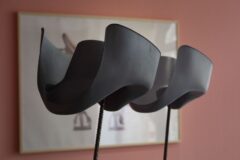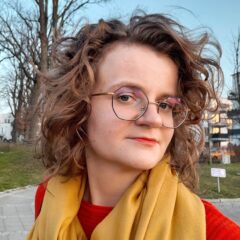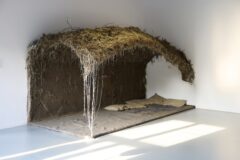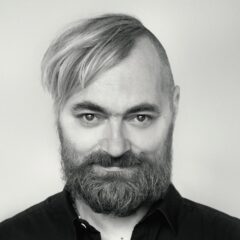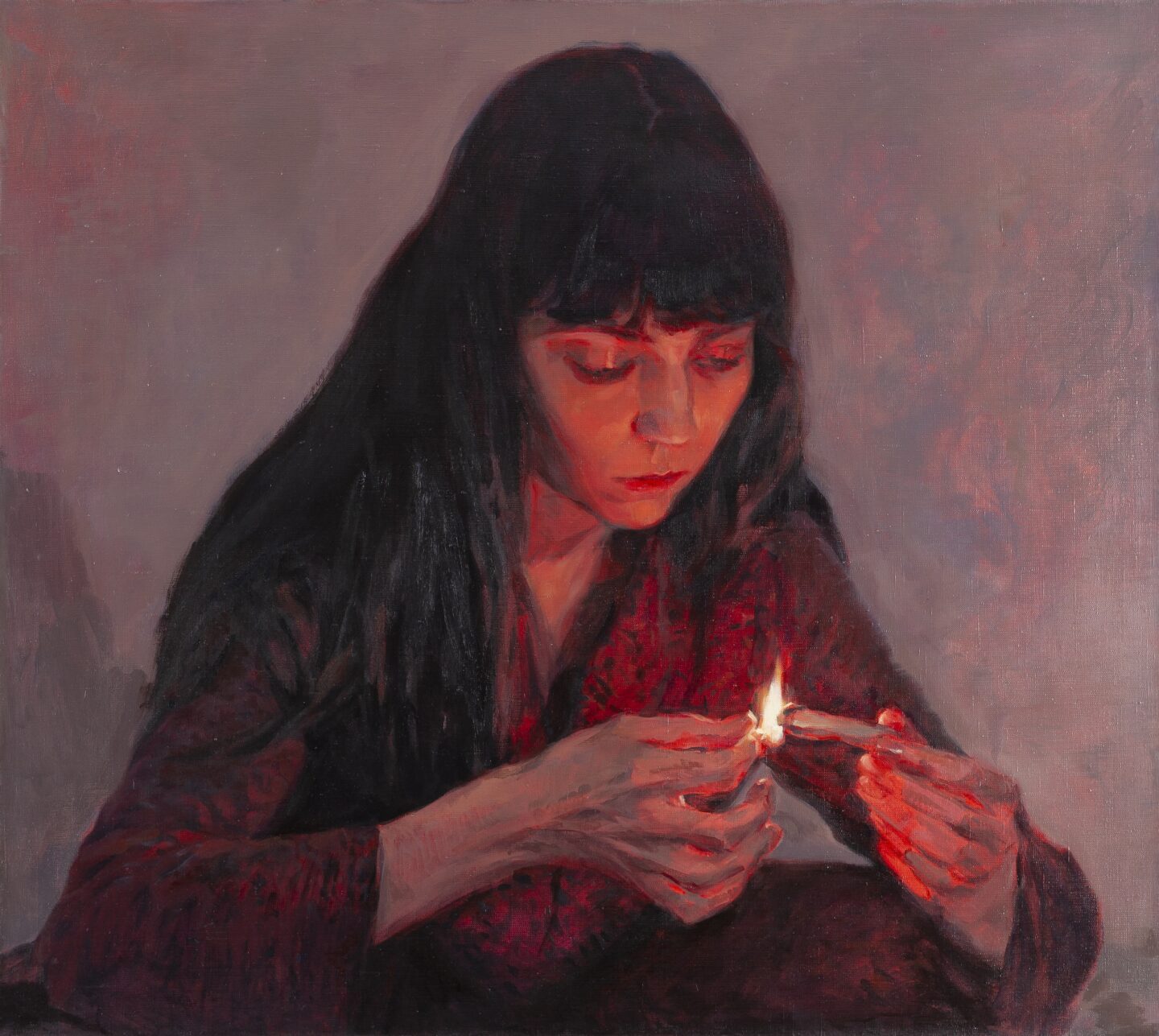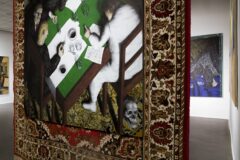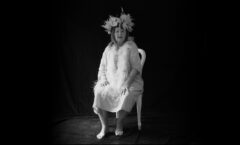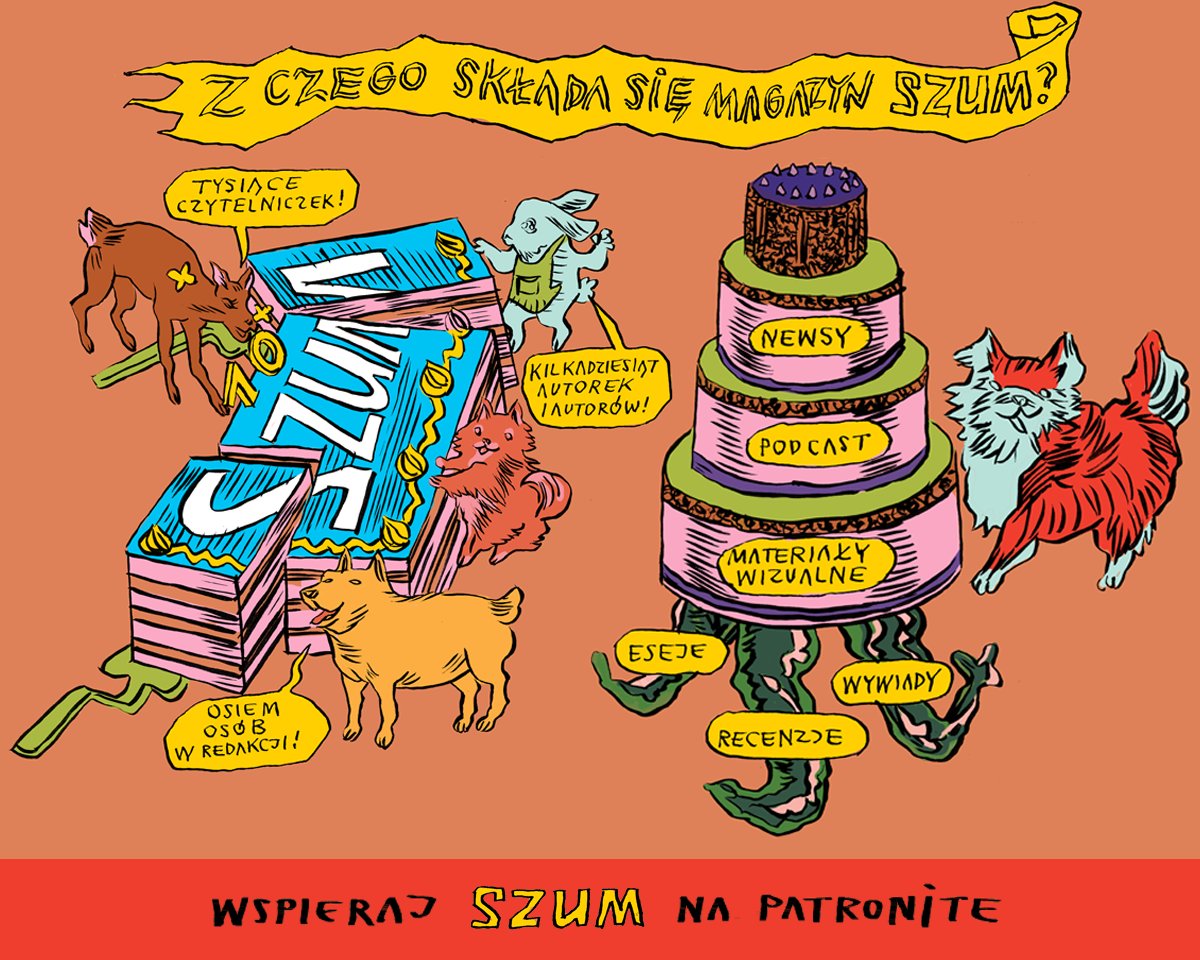Na kolanie, ale w słusznej sprawie / Scrawling and scribbling for a good cause
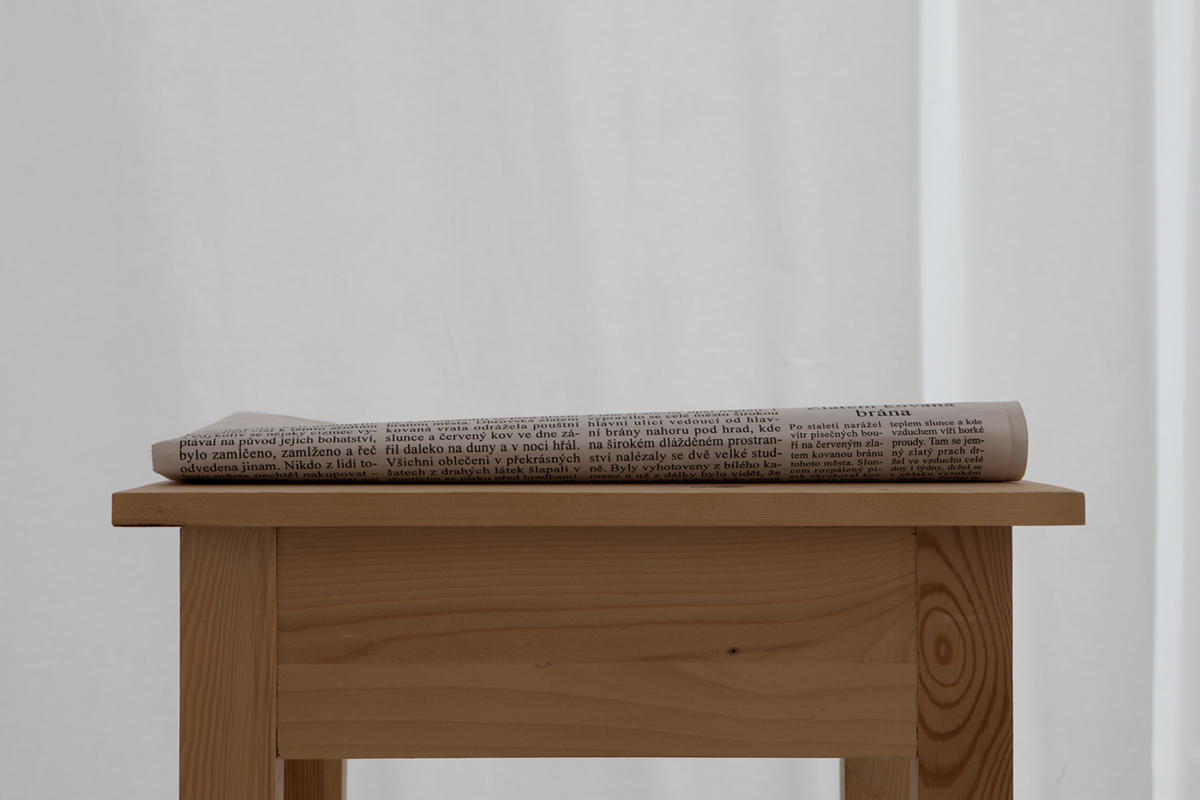
For English version scroll down
PL
Wszyscy, których spotkałem na swojej rezydencji w Pradze, mówili zgodnie: w kwestii zaangażowania artystów w problemy społeczne i krytycznego podejścia do rzeczywistości młoda czeska scena nie ma wiele do zaproponowania. Ja odkryłem, że nie mieli racji.
Dotychczas krytyczną postawą wyróżniała się działająca od 2005 roku galeria Artwall, która zabierała głos w sprawach korupcji (Guma Guar, Collective Identity), dyskryminacji mniejszości etnicznych (Tomáš Rafa, True Patriotism) czy przemocy seksualnej (Alma Lily Rayner: Some Things My Father Put Inside My Vagina). Komunikaty wysyłane przez realizowane w Artwall projekty są bezpośrednie i publicystyczne, a dla niektórych przypadkach nawet łopatologiczne.
W ciągu ostatniej dekady „krytyczne” postawy najsilniej były i są reprezentowane przez czeskie grupy artystyczne, niezmiennie chętnie używające w swoich pracach żartu, ironii i przesady.
Może to stereotyp, ale jako naród Czesi znani są raczej z poczucia humoru i traktowania rzeczywistości z przymrużeniem oka. Jak pięknie ujął to Przemysław Witkowski, to hedonistyczni pragmatycy, a „ich kultura nastawiona jest na sprawianie sobie przyjemności w rozsądnych ilościach. Legalna jest trawka, piwo w lokalach jest tanie, kuchnia tłusta i kaloryczna”. W najbardziej świeckim kraju Europy widmo radykalizującego się nacjonalizmu nie jest tak silne jak w Polsce czy na Węgrzech, a kler nie dyktuje wszystkim jak żyć, więc czym się tu przejmować?
W ciągu ostatniej dekady „krytyczne” postawy najsilniej były i są reprezentowane przez czeskie grupy artystyczne, niezmiennie chętnie używające w swoich pracach żartu, ironii i przesady: aktywne od początku lat 2000, tworzone głównie przez artystów z roczników siedemdziesiątych, kolektywy takie jak Guma Guar, Rafani czy Ztohoven. Wszystkie chętnie posługiwały się w swojej działalności humorem – krytykę czeskiego społeczeństwa uskuteczniały przez nabijanie się z niego. W 2008 roku, kiedy członkowie Ztohoven wdarli się na antenę jednej ze stacji telewizyjnych, widzowie prognozy pogody zobaczyli atomowy grzyb unoszący się nad panoramą Karkonoszy.
Na czeskim humorze nie poznały się w 2005 roku władze Bytomia, kiedy na wystawie Bad News w CSW Kronika znalazła się praca grupy Guma Guar. Plakat Wszyscy jesteśmy ciotami, przedstawiający uśmiechniętego papieża Benedykta XVI w triumfalnym geście trzymającego odciętą głowę Eltona Johna, oburzył miejskich radnych i ostatecznie zniknął ze ścian galerii. Milan Mikuláštík, jeden z członków grupy, z żalem wspomina całą aferę i to, co w jego odczuciu było aktem cenzury ze strony kuratorów galerii.
Młodzi artyści z Czech i Słowacji dużo chętniej i z dużo większym luzem niż Polacy reinterpretują dziedzictwo komunizmu.
Dziś Mikuláštík prowadzi pracownię supermediów na Akademii Sztuki, Architektury i Designu UMPRUM. Razem z nim i jego studentami pojechałem do Uścia nad Łabą, niewielkiego poprzemysłowego miasta na północy kraju. Funkcjonuje tu akademia, regularnie odbywają się ciekawe wystawy. Galeria Emila Filly mieści się na obrzeżach miasta, w przemysłowym kompleksie z czerwonej cegły. Na niższych kondygnacjach robotnicy mieszają chemikalia, po korytarzach roznosi się specyficzny zapach. Podczas mojej wizyty w monumentalnej hali trwała akurat wystawa Recycling Ideology, prezentująca prace artystów zainteresowanych różnego rodzaju ideologiami politycznymi. Znalazł się tu między hipsterski manifest-magazyn lajfstajlowy malarskiej grupy Black Hole Generation (której twórczość prezentowała w Warszawie galeria Leto) oraz obraz Vladimíra Houdka reinterpretujący tatlinowski pomnik Międzynarodówki. Słowacki duet Dávid Demjanovič i Jarmila Mitríková w serii surrealistycznych prac na drewnie odwołuje się do śmieszno-strasznej estetyki oficjalnej sztuki poprzedniego ustroju. Warty uwagi jest fakt, że, młodzi artyści z Czech i Słowacji dużo chętniej i z dużo większym luzem niż Polacy reinterpretują dziedzictwo komunizmu. Na jednej z prac w galerii Emila Filly, Marx Christmas, mężczyzna w czapce świętego Mikołaja na głowie siedzi na kolanach autora Kapitału.
Najodważniej do tematu podchodzą chyba tzw. Radykalni Realiści, artyści z pełną powagą nawołujący do rehabilitacji sowieckiej sztuki z pierwszej połowy XX wieku i socrealizmu. Swoje postulaty przedstawili podczas pierwszego kongresu Związku Artystów Sowieckich, który w zeszłym roku odbył się w Tranzitdisplay. Chociaż kilka osób przekonywało mnie, że to zupełnie na serio i nie ma się co śmiać, ja nauczony doświadczeniem przyjąłem wszystko z rezerwą.
***
– To jest lewo, a to prawo. Lewo, prawo, lewo, prawo… – smukłe śniade dłonie wskazują kierunki i zataczają kręgi wśród roślin doniczkowych w nieokreślonej biurowej przestrzeni. Dochodzący zza kadru kobiecy głos jest zdecydowany i monotonny, dłonie układają się w kolejne figury: chwytają i rozciągają niewidzialny sznurek, palec wskazujący pociera delikatnie o kciuk. – Lewo, lewo, lewo, prawo, lewo, prawo…
W kolejnych ujęciach pogrążona w transie tancerka sunie po pustych korytarzach anonimowego gmachu – może to szkoła, szpital, urząd? Jeden z elementów systemu kontroli państwa nad obywatelami. W tle słychać elektroniczną muzykę, na ekranie wyświetlane są sekwencje słów: This is not politics. This is something else. This is pantomime…
Tancerka to Meïmouna Coffi, jest również autorką choreografii. Ustawienia dłoni i ciała oparte są na gestach wykonywanych przy obsłudze dotykowych urządzeń elektronicznych. Teledyskowa praca Shattered Epistemologis to dzieło Jiří Žáka, młodego praskiego artysty wideo. To kolejny z jego wideo-esejów, w których eksploruje on medium filmu, bada relacje między tekstem, obrazem i dźwiękiem. Tym razem, przy okazji współpracy z Coffi, w centrum jego zainteresowania znalazły się kwestie dystrybucji informacji, języka mediów oraz medialnych konstruktów „prawdy” i „post-prawdy”. Rytmiczna, atrakcyjna forma filmu z minuty na minutę staje się coraz bardziej niepokojąca. Coffi wije się, obija o ściany, dół miesza się z górą, lewa strona z prawą.
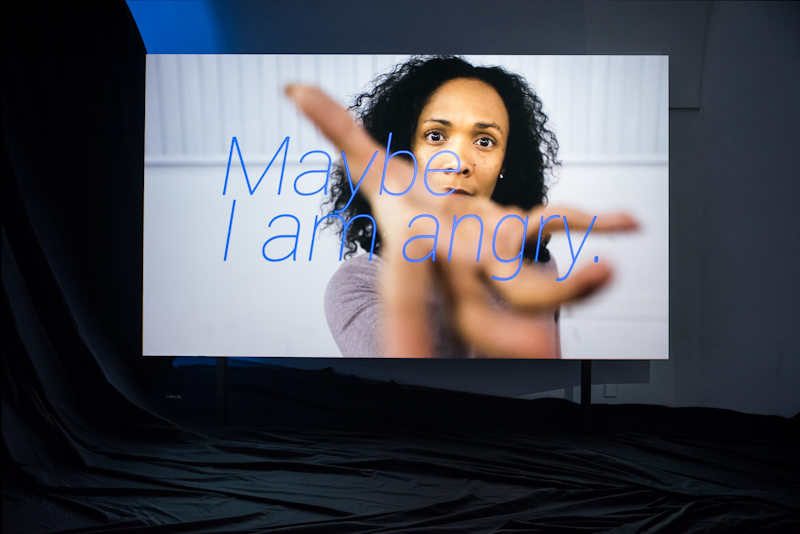
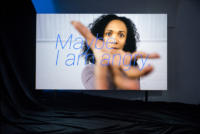

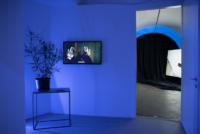

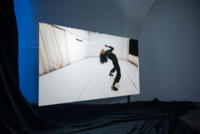
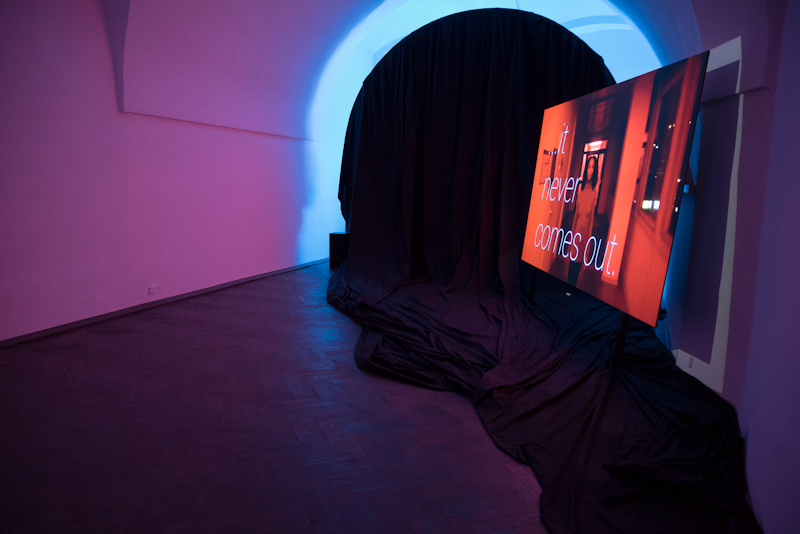
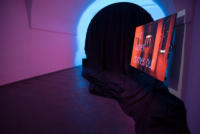
Pokój w galerii Jelení przedzielony jest białym, sprężystym materiałem. Przepuszcza światło, ale nie pozwala zobaczyć, co dzieje się po jego drugiej stronie, tego „co jest za ścianą”, jak mówi tytuł wystawy Victora Dedka (What is behind the Wall). W pomieszczeniu na niewielkim drewnianym stoliku leżą przygotowane przez Dedka gazety – każdego dnia przybywa jedna, pisana na podstawie tego, jak danego dnia potoczy się opowieść. Po pustej przestrzeni wokół stolika spaceruje aktor, z przejęciem opowiada historię: wymyśla ją na bieżąco i kontynuuje, aż zwiedzający wyjdą z galerii. Historie ciągną się pozbawione pointy, punktów zwrotnych, morału. Punktem wyjścia była ostatnia z opowieści Szeherezady, ale ten kontekst szybko przestał mieć znaczenie. Każdego dnia trwania wystawy aktorzy zmyślają, zaprzeczają sami sobie, a następnie ich historie zostają dodatkowo zdeformowane w leżącej na stoliku gazecie.
Jiří Žák i Victor Dedek to dwaj zupełnie odmienni artyści. Pierwszy nie stroni od dosłowności, z chęcią wykorzystuje język mediów i reklamy, świadomie korzysta z możliwości techniki filmowej. Dedek ucieka od dosłowności jak najdalej, tworzy zawiłe opowieści i chowa się w świecie fantazji. Obaj na różne sposoby podchodzą do tematu „post-prawdy”, najmodniejszego słowa 2016 roku, które wcale nie przestaje wychodzić z użycia. Jeżeli ustawilibyśmy ich na jednej osi, pierwszemu bliżej byłoby do publicystyki, drugiemu do poezji. Žák został już rozpoznany na lokalnej scenie, w 2015 roku był laureatem prestiżowej nagrody EXIT. Z każdym filmem – czego dowodem jest Shattered Epistemologist – prezentuje coraz to wyższy poziom koncepcji i formy. Dla Dedka prezentacja w Jelení to indywidualny debiut i wielkie wyróżnienie, obecnie pracuje on nad dyplomem w pracowni Dominika Langa.
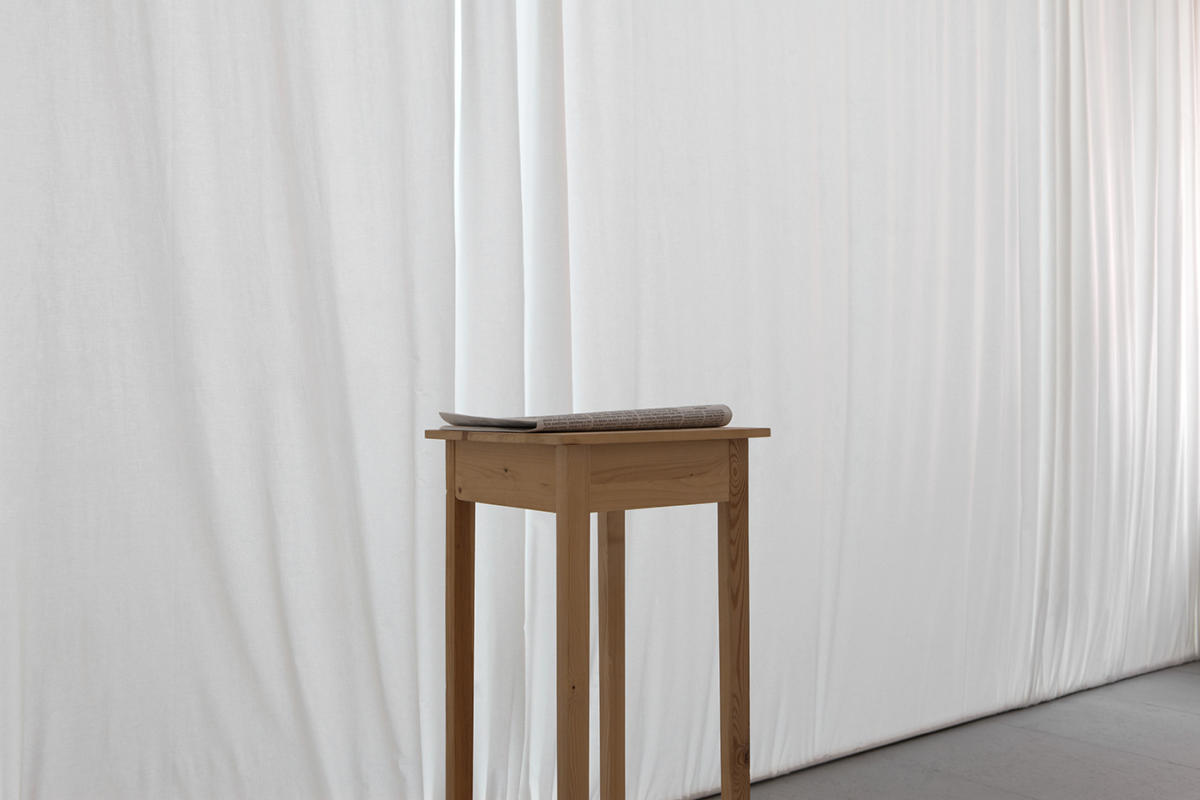
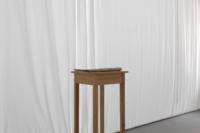

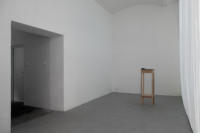
Žák i Dedek są członkami Studia bez Profesora (Ateliér bez vedoucího), międzyuczelnianej grupy zrzeszającej studentów oraz absolwentów kierunków około artystycznych. Spotykają się raz w tygodniu, by konsultować i dyskutować swoje pomysły. Rozmawiają i uczą się od siebie nawzajem, przekazując wiedzę w niehierarchiczny sposób. Obecnie do Ateliér… należy około dziesięciu osób. Zajmują się krytyką instytucji edukacyjnych i szukaniem nowych dróg dystrybucji wiedzy.
Członkiniami Ateliér bez vedoucího są także tworząca wideo Marie Lukáčová i malarka Martina Smutná. Chociaż zaangażowane w zmienianie otaczającego je świata, zdecydowały się działać poza hermetycznym językiem sztuki.
Dziewczyny z Czwartej Fali w krótkim czasie stały się ważnym głosem w walce o równouprawnienie kobiet w świecie artystycznym. A w tym temacie, mimo że scena czeska wydaje się bardzo nowoczesna i świadoma, nadal pozostaje bardzo wiele do zrobienia.
Razem Evą Svobodovą powołały do życia feministyczną inicjatywę Čtvrtá vlna – Czwarta Fala. Polem ich działania jest Facebook. Produkują i zamieszczają na nim krótkie, viralowe filmy o feministycznym przesłaniu, zwiększając świadomość i podważając stereotypy. Pierwszy klip, poświęcony seksizmowi na uczelniach artystycznych, miał czterysta tysięcy odsłon i wywołał szeroką dyskusję. „Przy całej sali powiedział, że wyglądam jak gwiazda porno”, „O moich pracach usłyszałam: tylko kobieta mogła wymyślić coś tak gównianego”, „99% pracowni jest prowadzonych przez mężczyzn” – napisy przesuwają się kolejno po ekranie. Dziewczyny z Czwartej Fali w krótkim czasie stały się ważnym głosem w walce o równouprawnienie kobiet w świecie artystycznym. A w tym temacie, mimo że scena czeska wydaje się bardzo nowoczesna i świadoma, nadal pozostaje bardzo wiele do zrobienia. W tym roku odbyła się kolejna edycja Zlińskiego Salonu Młodych (Zlínský salon mladých), imprezy organizowanej od 1996 roku, pomyślanej jako Triennale Współczesnej Sztuki Czeskiej, a od 2005 roku również słowackiej. Powiedzieć, że nikt z organizatorów nie słyszał o czymś takim jak gender balance to mało: do udziału zaproszono 33 artystów i jedną (!) artystkę. Portale A2larm i Artalk.cz opublikowały list otwarty, którego sygnatariuszki wezwały organizatorów i kuratorów, do zakończenia tego pokazu mizoginii. Trzeźwo zareagował Martin Kohout i zrezygnował z pokazania na wystawie swoich prac. W jego miejsce zaprezentowano film Czwartej Fali, traktujący o nierównościach czechosłowackiego artworldu.
Podczas mojej pierwszej wizyty w autonomicznym centrum kultury Klinika, artysta-anarchista Max Máslo wręczył mi jedną z produkowanych przez siebie wlepek: rysunkowa postać z sierpem i młotem w dłoni z uśmiechem jedzie na deskorolce. To część większego projektu, w którym Máslo bada, czy kumpelskie deskorolkowe relacje da się przemienić w socjalistyczną rewolucję. Koniec końców, ten obrazek okazał się najtrafniejszą metaforą młodej alternatywnej sceny, którą dane było mi poznać w Czechach: skupiona na kolektywności, narysowana może trochę na kolanie, ale na wesoło działająca w słusznej sprawie.
ENG
All the people I met during my stay in Prague seemed unanimous: when it came to young artists’ commitment to social issues and their critical approach towards reality, the young Czech scene had little to offer. I discovered it was not true.
So far, a venue distinguished by its critical attitude has been the ArtWall gallery, launched in 2005. It spoke up against corruption (Guma Guar: Collective identity), discrimination of ethnic minorities (Tomáš Rafa: True Patriotism) or sexual violence (Alma Lily Rayner: SomeThings My Father Put Inside My Vagina). The projects completed at ArtWall have always sent a very clear, direct message. Some have even called them blunt.
Over the last decade the more „critical” approach has been largely represented by groups comprising artists born in the seventies and active since around the year 2000.
It may well be a stereotype, but Czech people are usually perceived as good-humoured and somewhat indulgent. As Przemysław Witkowski brilliantly put it, they are hedonistic pragmatics whose culture „is aimed at delivering pleasure in reasonable quantities: weed is legal, beer in taverns is cheap, the food is fatty and caloric”. In Europe’s most secular country the menace of radical nationalism is nowhere near as present as in Poland or Hungary. The clergy here does not attempt to tell everybody how they should live. So, why would one worry?
Over the last decade the more „critical” approach has been largely represented by groups comprising artists born in the seventies and active since around the year 2000. Among such collectives, all of which focus on jokes, irony and hyperbole, we will find Guma Guar, Rafani or Ztohoven. The favourite tool for all of them is humour: their way of applying critical thinking to the Czech society is mockery. In 2008, when members of Ztohoven managed to hack the broadcast of one of the Czech networks, the audience watching the weather forecast saw a mushroom cloud over the skyline of Krkonoše mountains.
The officials of the Polish city of Bytom did not seem to be able to appreciate Czech humour back in 2005, when Guma Guar group presented their work at the „Bad News” exhibition held by the local centre for contemporary art (CSW Kronika). Their poster entitled „We’re all queers” (Wszyscy jesteśmy ciotami), depicting a smiling pope Benedict triumphantly holding up Elton John’s severed head, outraged some of the councilmen and was eventually taken off the gallery wall. Milan Mikuláštík, one of the group members, has bitter memories of the scandal and of what he saw as an act of censorship by the gallery curators.
Young Czech and Slovak artists are much more eager and relaxed when it comes to reinterpreting the communist legacy than their Polish counterparts.
Mikuláštík is now head of the supermedia section of the UMPRUM Academy of Art Architecture and Design. I joined him and a group of his students for a short trip to Ústí nad Labem, a small postindustrial town in the northern part of the country. An academy operates there, and interesting exhibitions are frequently held. The Emila Filly gallery is located in the outskirts, inside a red brick industrial complex. In lower storeys workers still mix chemicals, so a peculiar scent wafts in the corridors. During my visit the gallery’s monumental hall housed Recycling Ideology, an exhibition of works of artists interested in various political ideologies. Among the exhibits there were, e.g. the lifestyle magazine and hipster manifesto created by the Black Hole Generation painter group (some of their work was presented in Warsaw at the Leto gallery) or Vladimír Houdk’s painting being a reinterpretation of the Tatlin memorial of The International. The Slovak duo Dávid Demjanovič and Jarmila Mitríková, on the other hand, contributed a series of surrealist works on wood exploring the equally scary and funny aesthetics peculiar to the official art of the previous regime. What is worth mentioning is that young Czech and Slovak artists are much more eager and relaxed when it comes to reinterpreting the communist legacy than their Polish counterparts. For instance, Marx Christmas, one of the works exhibited at the Emila Filly gallery, shows a man wearing a Santa Claus hat seated in the lap of the author of „Capital”.
The ones who seem the boldest in this respect are the so-called Radical Realists: artists who very seriously support the rehabilitation of both Soviet Art of the first part of the 20th century and socialist realism. They voiced their postulates for the first time at the 1st congress of the Soviet Artists Association, an event held last year at Tranzit.Display. Several people tried to convince me that it was all for real and very serious, but I chose to trust my experience and approached the whole thing with reserve.
***
„Left, and now right. Left, right, then left…”, slender olive-skinned hands indicate directions and circle around potted plants in an unknown, undefined office space. The voiced-over female narrator sounds decided and somewhat monotonous. The hands shape themselves into more and more forms: they pick up and stretch out an invisible piece of string, the index finger then gently rubs the thumb. „Left, left, left, right, right…”. In the following shots we see a female dancer immersed in a trance moving along the corridors of an empty edifice. Is it a school? A hospital? A state agency of some kind? Certainly, one of the many cogs in the state’s mechanism of controlling the people. The images are accompanied by electronic music. Sequences of subtitles on the screen say: This is not politics. This is something else. This is pantomime…
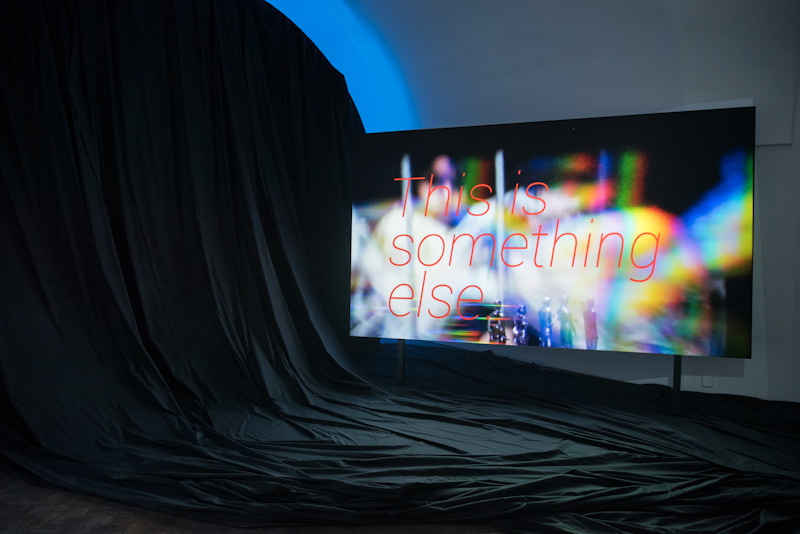

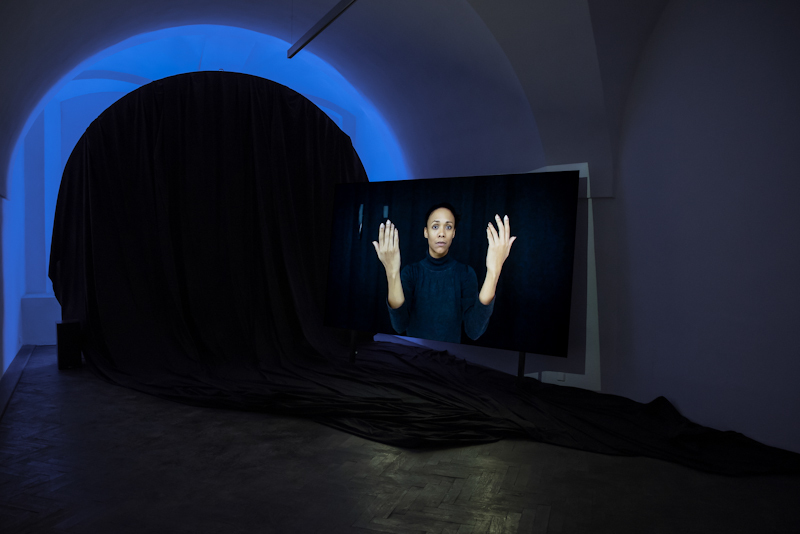
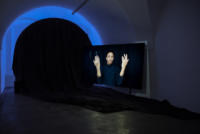
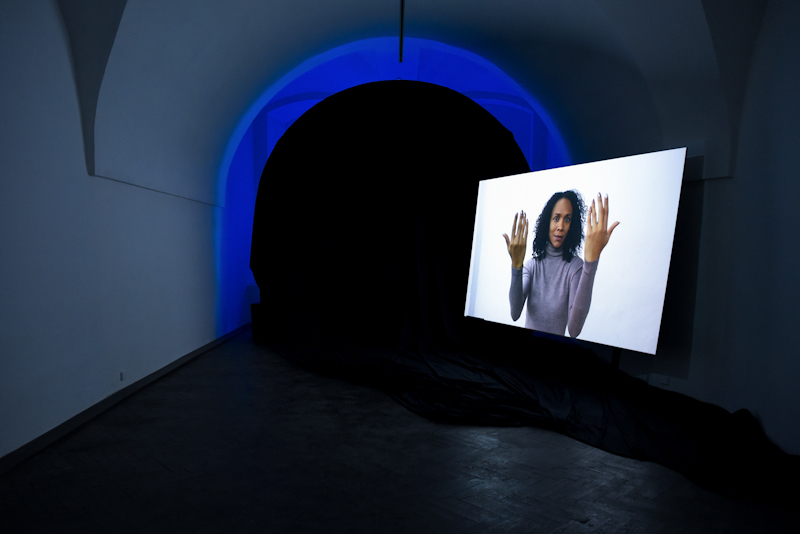

The dancer is Meïmouna Coffi. She is also the author of the choreography. The moves of the hands and the body are based on gestures we make while using touch-screen electronic devices. The music-video-like Shattered Epistemologis is a work of Jiří Žák, a young video artist from Prague. It is the most recent one among his video essays in which he explores film as a medium, investigating the relations between text, image and sound. This time, on the occasion of collaborating with Coffi, he chose to focus on distribution of information, the language of the media, and the media concepts of „truth” and post-truth. The rhythmic eye-catching form of the video gets more disturbing with every passing minute. Coffi winds, bounces of walls, confuses sides and directions.
One of the rooms in Jeleni galley is divided with white firm fabric. It lets some light through, but impedes you from seeing what is going on on the other side, „behind the wall”. The latter is directly connected to the title Victor Dedek’s exhibition bears: What is behind the Wall. In the room, on a small wooden table, there are newspapers prepared by the artist. Each day a new one appears: the headlines reflect the current episode of the story. An actor circles the table time and again recapitulating „the news” in a state of agitation. He comes up with new passages and continues until the last visitors leave the gallery. The stories have no punchline, no moral, no pivot points. They just go on, and on, and on. At the very beginning, the reference point for this act was the last one of Scheherazade’s tales, but that context soon ceased to be important. Every day of the exhibition actors make up new stories, often contradicting their own previous statements. And then, those stories of theirs are yet more distorted in the „newspaper on the table.
Jiří Žák and Victor Dedek are two very different artists. The former does not avoid literality, and gladly reaches for the language of both the media and advertising. He consciously uses the means provided by filming technology. Dedek runs as far as possible from literality. He creates complex, convoluted stories and hides in the universe of fantasy. Each artist has his own approach towards the concept of „post-truth”, arguably the trendiest word of 2016, which does not seem to be losing popularity. If we tried to compare the two artists using one axis, the first one would end up closer to journalism, and the second one: to poetry. Žák has already earned a renown within the local scene: in 2015 he won the prestigious EXIT award. With each new film, as Shattered Epistemologist well proves, he reaches higher levels both as regards concept and form. For Dedek, on the other hand, the exhibition in Jeleni is an individual debut and a major act of appreciation. The artist is now working on his graduation work at Dominik Lang’s studio.




Žák and Dedek are both members of Ateliér bez vedoucího (Studio without a professor), an inter-university initiative bringing together students and graduates of art-related faculties. They meet once a week to discuss and confront their ideas. They talk and learn from one another, transmitting knowledge and skills in a non-hierarchic way. At the moment Ateliér has about ten members who focus on criticism of education and finding new ways for the distribution
of knowledge.
The Fourth Wave quickly became a significant voice within the struggle for gender equality in the artistic circles. The latter, even though the Czech scene seems very modern and conscious, remains an area where a lot needs to be done.
Another members of Ateliér bez vedoucího are video artist Marie Lukáčová and painter Martina Smutná. Despite their commitment to changing the world around them they chose to act outside the hermetic reign of the language of art. Together with Eva Svobodova they launched a feminist initiative called Čtvrtá vlna (The fourth wave). Their area of activity is Facebook. They produce and post short viral videos carrying a feminist message, raising awareness and challenging stereotypes. Their first material, speaking about sexism within artistic faculties, got four hundred thousand hits and generated a major discussion. „In front of everybody in the room he told me I looked like a porn star”, „An opinion about my work: >>only a woman could have came up with something this shitty<<„, ”99% of studios are run by men”, those are some of the captions appearing on screen. The girls from The Fourth Wave quickly became a significant voice within the struggle for gender equality in the artistic circles. The latter, even though the Czech scene seems very modern and conscious, remains an area where a lot needs to be done. This year saw another edition of Zlínský salon mladých (Zlinsky youth salon), an event organised since 1996 and intended as a triennale of contemporary Czech (as of 2005: also Slovak) art.
To say that, apparently, none of the officials here has heard of gender balance would be to say nothing: among the 34 artists invited to take part there was one (!) woman. A2larm and Artalk.cz websites published an open letter in which signatories called on the organisers and the curators to put an end to this display of misogyny. A very sober reaction came form Martin Kohout, who simply withdrew from showing his work at the event. The slot he left free was used for presenting Fourth Wave’s film about the inequalities within the Czech artworld.
During my first visit to the autonomous cultural centre Klinika artist and anarchist Max Máslo gave me one of his slap tags. It showed a smiling cartoon character riding a skateboard with a hammer and a sickle in his hands. That sticker art is a part of Máslo’s bigger project: he is about to investigate if matey skate friendships can be turned into a socialist revolution. In the end, that image seems to me the most accurate metaphor for the young alternative scene I was able to get to know in the Czech Republic: it is about the collective, and albeit done somewhat roughly it happily rides forward for a good cause.

This article was produced under East Art Mags, a residency program for critics from Central and Eastern Europe.
Jakub Gawkowski — jest kuratorem i historykiem sztuki, pracuje w dziale sztuki nowoczesnej Muzeum Sztuki w Łodzi. Absolwent Uniwersytetu Środkowoeuropejskiego w Budapeszcie. Kurator i współkurator wystaw m.in.: Erna Rosenstein, Aubrey Williams. Ziemia otworzy usta (Muzeum Sztuki, 2022), Atlas Nowoczesności. Ćwiczenia (jako część zespołu kuratorskiego, Muzeum Sztuki, 2021), Ziemia znów jest płaska (Muzeum Sztuki, 2021), Agnieszka Kurant. Erroryzm(Muzeum Sztuki, 2021), Die Sonne nie Świeci tak jak słońce (Trafostacja Sztuki, 2020), Diana Lelonek. Buona Fortuna (Fondazione Pastificio Cerere, 2020), Najpiękniejsza Katastrofa (CSW Kronika, 2018). Stypendysta European Holocaust Research Infrastructure oraz programu DAAD theMuseumsLab 2022.
Więcej

